In 1987, my wife and I took our three children on a camping trip in the Southwestern United States. We ended up in Santa Fe, New Mexico, and when I wandered into a shop on Canyon Road that was named Folklorico, I walked into a new world—the world of great Mexican masks. That day I met Robin Cleaver, and bought five masks. I can still remember some masks that I did not buy, and should have. We returned home to Pennsylvania, and I made further contact by telephone and letter. This led to my meeting Robin’s wife, Barbara Cleaver. I soon discovered that Robin, Barbara, and I were similarly afflicted with great enthusiasm for beautiful folk art. Barbara quickly became a mentor. Her main point was very simple—because there were so many false and invented Mexican masks on the market, I would be well advised to learn as much as I could about the two categories that I would need to differentiate, the genuine and the decorative. As of 1988, Barbara had recommended six books, along with comments that went something like this:
1. Mexican Masks, by Donald Cordry, published by the University of Texas Press in 1980. “Cordry’s book is very important because, although many of the masks are not good, there are others that are very good.”
2. Máscaras, by Estela Ogazon, published by the Museo Universitario de Ciencias y Arte, in 1981. “All of the masks in Máscaras are good. While I do not necessarily agree that they are all labeled correctly, they are all excellent and real.” I would agree.
3. A Celebration of Masks: Mexican Masks from Chicago Collections/ Celebración de Máscaras: Máscaras Mexicanas de Colecciones de Chicago, Mexican Fine Arts Center, Chicago, 1984. Barbara was intrigued that this book demonstrated the influence of Cordry’s book on American collectors.
4. Changing Faces: Mexican Masks in Transition, by Lori Jacobson and Donald E. Fritz, published by the McAllen International Museum, in 1985. Barbara noted that Changing Faces provided the best discussion about the flood of Mexican decorative masks that had appeared in recent decades. It was a book that every aspiring collector of Mexican masks simply had to read.
5. Mascaras: La Otra Cara de México. Masks: The Other Face of Mexico (3rd edition), by Victor José Moya Rubio, published by the Universidad Nacional Autónoma de México, in 1986. Barbara described Moya Rubio’s book as another instance where wonderful material was mixed with an occasional false or decorative mask. The great things were not to be missed. I am adding the suggestion for the 1986 printing, because the third edition is bilingual, and thus particularly useful.
6. Behind the Mask in Mexico, edited by Janet Brody Esser, and published by the Museum of International Folk Art in 1988. The museum, in Santa Fe, New Mexico, created a truly wonderful traveling exhibit on the subject of Mexican masks and dances, and with it this accompanying book.
On reflection, of the books that were available at that time and soon after, there are two others that I find as essential as the other six. These are:
7. Catálogo de Máscaras del Estado de Guerrero de las Collecciones del Museo Nacional de Antropología, by María Teresa Sepúlveda Herrera, published by the Instituto Nacional de Antropología e Historia in 1982.
8. Museo Nacional de la Máscara, San Luis Potosi, Mexico: Catálogo, published by FONAPAS (Fondo Nacional para Actividades Sociales), circa 1981. This volume provides a fuller listing of the Moya Rubio collection, with valuable information regarding the dance and the place of origin for many good masks.
Recently Tom Pirazzini provided me with a copy of his self published book—Dealers of Mexican Folk Art. This begins with a valuable list of reputable dealers, followed by an extensive list of interesting web sites, then morphs into a long and interesting discussion of decorative masks that extends from page 10 through page 25. I will include some of his ideas and observations in the discussion that follows.
With this list of nine references in place, I can begin to discuss the subject of decorative masks. After I have completed that review, I will share some photographs of authentic masks, to repay you for your attention to what may seem a short, but dry lecture. (Also see FAQ #7 re Made For Sale versus Decorative masks.)
Mexican Masks was published posthumously, in 1980, two years after Donald Cordry’s death. I will briefly discuss this book after I review the other books in this list, and then at length in three posts to follow. The point that I want to make here is that Cordry did briefly describe the emerging problem of falsely presented and falsely aged masks, but seemingly with no awareness that his book was filled with examples of such masks (page 31).
Sepúlveda Herrera set out to review all of the masks in the collection of the National Museum of Anthropology, in Mexico City, that were labeled as having been made in the Mexican state of Guerrero. She divided those masks into three categories—authentic, decorative, and there were three masks that she called “desconocido” (unknown). As far as I know, this was the first meaningful published description of Mexican decorative masks. Of these, the author said that in recent years there had appeared a large number of masks that had the appearance of great age, but these had no connection with recognized traditional dances. It emerged that the production of reproduction masks had become a cottage industry in some areas of Guerrero. At first these were copies of traditional human and animal masks, but gradually the carvers extended their production to versions that were more fantastic and elaborate, and they added false evidence of patina. These were being widely collected (pages 215- 217). I want to emphasize that most of the masks that were classified in Sepúlveda Herrera’s book as authentic are very good, well documented regarding their respective dance and place of origin, and worthy of our study. On the other hand, there are several more that would now be regarded as also decorative. These differ from those identified as decorative by the author, which were rather crudely carved, while the unlabeled decoratives are much like those in Cordry’s book. The author listed Mexican Masks in the Bibliography but I found no reference to that book in the text. Sepúlveda Herrera’s book is out of print, but occasionally available on the Internet.
Interest in the full range of masks found in Cordry’s book is evident in the Celebration of Masks book. It is noted in the Preface that this “admittedly personal selection emphasizes form, craft, and the inventive use of materials rather than age and guaranteed authenticity (3).” The curator of the exhibition, Robert W. Anderson, began by noting that dance masks had traditionally been used for ceremonial interaction with supernatural forces. But when these masks passed into the hands of collectors, and were no longer connected to their traditions of origin, Professor Anderson felt free to look at them as works of art. He was particularly interested in the bearded masks, which seemed to reflect the Baroque style that was introduced by the Spanish in the 16th century. On the other hand, masks that combined human faces with animals seemed to reflect indigenous beliefs in shamanism and the shaman’s transformation into totem animals.
When I was writing my book—Mexican Masks and Puppets—I was surprised to discover evidence that the masks and dances of the Sierra de Puebla had probably been shaped by a desire to serve pre-conquest supernatural forces until just a century ago. Since then there has been more of an emphasis on injustice, unresolved social tensions, and the maintenance of indigenous identity. I found all this quite interesting, and I would never want to sacrifice this perspective to one that focused solely on artistic aspects. Then again, I do find the artistic qualities of Mexican dance masks to be highly engaging.
My friend Charles (“Chuck”) Thurow, one of the initiators of the Chicago exhibit and the Celebration of Masks catalogue, and at the same time one of the lenders of material, recalls that the catalogue descriptions were not based on information that was provided by the lenders, but apparently reflected the perceptions and beliefs of the curator. Although one might think that the Chicago collectors read Cordry’s book, and then collected in response to his presentation, this was not exactly the case. Chuck, along with his partner, the late Dale Hillerman, was aware of Cordry’s collection when that collector was still alive, and he had actually visited Cordry in Mexico, hoping to purchase masks that were to appear in the book, even though he knew that they were not traditional, because he viewed them as special. This reflects Chuck’s preference to divide the masks that are usually called decorative into three separate clusters. Like Anderson, Chuck perceives the elaborately carved masks with curly beards (such as #175, #176, #177, #180, and #181 in the Celebration of Masks book) as a response to the Baroque influence of Spanish Catholicism, a natural extension of the work of the santeros, the carvers of saints. He acknowledges that these masks were carved for sale to non-Indians, and were not for traditional use, but he is impressed by the quality of their carving, and sees them as genuine folk masterpieces. He doubts that those masks were specifically invented to fool Donald Cordry, but he does perceive them as part of an artistic tradition, and not intended for either ecclesiastical or ceremonial use. On the other hand, Chuck believes that the masks in a second cluster of masks were very carefully carved, and otherwise prepared, solely for the purpose of selling them to Cordry. For this reason they demonstrate an unusual level of quality and inventiveness, so that these were the ones that Chuck sought out to purchase. Furthermore, he was most interested in the process that led to their creation, the interaction between Cordry and the Indian carvers. Briefly, a carver or intermediary would bring Cordry a mask. Cordry would respond with not only interest, but also curiosity, wondering whether there were other masks that went further in a particular direction. Indeed there were, his informant would reply, and through such a dialogue other masks would follow that were essentially made to order, except that Cordry was unaware that he was directing their manufacture. This process, as a specific example of the generic struggles between Indians and outsiders, interested Thurow as well, particularly because it led to new art forms and designs. While others emphasize the role of dealers in the development of the decoratives, Chuck maintains his gaze on the Indian artists who produced the initial examples of these new masks. A third cluster in Chuck’s analysis, which represents the progression to generic production of these new forms, leading to a tidal wave of mediocre masks that are falsely aged in a clumsy fashion, are the true decoratives (in Chuck’s view). I must add that Chuck is equally interested in authentic Mexican dance masks, as was Dale Hillerman, and their collection combines great examples of such masks, along with other vivid carvings that one might place in the decorative spectrum. You will see masks of theirs from both categories in later posts.
The problem of the decorative masks became more visible to English speaking collectors in 1985, with the publication of Changing Faces. Briefly, the McAllen Museum, in McAllen Texas, had assembled a collection of Mexican masks. During the process of cataloging this material, experts informed the museum that many of these masks were not authentic. The museum decided to assemble a panel of experts to evaluate these masks, in anticipation of an exhibit that would compare the authentic with the decorative; Ruth Lechuga and Janet Brody Esser were among the consultants. Because so many of the masks were not authentic, the visiting experts loaned authentic masks to the show, in order to display a representative group for comparison. Changing Faces was the catalogue that accompanied this display. This was the first English language publication to blow the whistle on the decoratives, as the authors described the exaggerated or frankly invented nature of these masks, their attribution to “imaginary dances,” and their falsified appearance due to artificial aging techniques. As was the case in Sepúlveda Herrera’s book, Changing Faces included Donald Cordry’s book in the Bibliography, but there was no reference to that book in the text. This is another out of print book that may be available on the Internet. In contrast to the perspectives provided by Robert Anderson and Charles Thurow in the last paragraphs, the Changing Faces authors underscored the “false” nature of these masks as a defining characteristic. On the other hand, they recognized that these masks could be less ambiguously viewed as artistic creations if they were honestly presented. The problem was, and remains, that so many of these masks are dishonestly presented.
Tom Pirazzini and his wife Alma went to Mexico City, in 1985, to see what they could learn about the decorative masks in Cordry’s book. The presumed perpetrators were unwilling to talk about their business dealings, and Cordry’s friends were reluctant to say anything that might upset Cordry’s widow, Dorothy. Tom reiterates the point that I had made earlier, observing that Cordry was quick to purchase masks that confirmed his theories. He emphasizes the terrible consequences of the deceptions about the decoratives—the dealers whose reputations were ruined and the collectors who lost thousands of dollars.
One can identify additional perspectives on the decoratives; for instance there is my own. I value the authentic masks over the invented ones because the former reflect traditional values and beliefs. I like to understand how a masked dance reflects or even reinforces an indigenous culture’s values. A fourth perspective that has been articulated by Indians of the Americas is that the traditional masks, dances, and cultural beliefs are associated with their sense of identity; the decoratives have the potential to cloud the value of the traditional masks in this respect.
Does any one of these perspectives trump all of the rest? Of course not. In fact, it is difficult to approach the decorative masks without mixed feelings of appreciation and regret, and each individual will develop his or her unique blend of responses to these masks.
I will note in passing that the dance photos provided by Ruth Lechuga in the beginning of the Changing Faces catalogue are excellent.
The experts who evaluated the Changing Faces collection could only report on what they knew, and it is obvious to me that they took a conservative approach. In my view, and based on my experience, I would change a few of their labels. I will list these later in today’s post, illustrated with photos from my collection.
In Behind the Mask in Mexico, Ruth Lechuga (a Mexican expert on the entire spectrum of Mexican folk art) provided an important paper—“Mask Making in Guerrero” (pages 215-244). Lechuga began with an informative survey of the dances and masks from the Mexican state of Guerrero. When she came to the subject of the decoratives, she immediately mentioned Mexican Masks, Cordry’s book, but with obvious ambivalence—”The late Donald Cordry was a close personal friend of mine and it is not my intention to detract from his memory. But for the sake of future work on the subject it is necessary to distinguish between real dance masks and those decorative sculptures that are sometimes mistaken for them” (page 219). Lechuga went on to say that she had been commissioned by the Museo Nacional de Artes e Industrias Populares, a museum in Mexico City, to evaluate the “fantastic masks and hitherto unknown dances discussed in the Cordry book.” Visiting towns and mask makers, she was able to identify traditional mask makers who had also produced some of these invented masks. Although Cordry’s book was a major vehicle in the confusing popularization of these creations, Lechuga explained that Cordry was a victim of the traders and dealers who had commissioned and then marketed these falsely presented masks. Behind the Mask in Mexico is yet another book that is out of print, but often available on the Internet.
The books that feature the Moya Rubio collection—Máscaras La Otra Cara and the Catálogo—make no mention of Donald Cordry or of his book, Mexican Masks, even in the Bibliography of Máscaras. Nor does either book address or even mention the problem of decorative masks. If you visit the Museo Nacional de la Máscara, in the city of San Luis Potosi, you will find an unexpected number of decorative masks on display, along with others that are authentic and good. As the authors of Changing Faces pointed out, the decoratives had found their way into many collections. Both books are out of print, but Máscaras, La Otra Cara is easy to find, while the Catálogo is rare, but even more valuable.
This finally brings us to the implicit or explicit focus of these other books, Donald Cordry’s book—Mexican Masks—also out of print, but easy to find. Briefly, about 33% of the masks in this book are authentic. However, no consensus document has ever been published to sort them out. In my next post, I will highlight exemplary dance photos, and in the following post I will draw attention to the best of the masks. A third post will confront those that are likely to be decorative. This lengthy examination, taken in combination with Changing Faces, as amended later in this post, and Lechuga’s chapter in Behind the Mask in Mexico, may prepare you to read these other books with enhanced understanding.
For the rest of this post I will identify masks in Changing Faces: Mexican Masks in Transition that I believe should be highlighted or relabeled, either because they are decorative or because they are better than the description in the caption would lead you to believe. I am listing them by number (and page):
Masks numbered 8, 9, and 10 (page 25)—If you stare at this trio long enough, you may begin to suspect that they are all by the same hand, as they share the same overall form. The authors obviously had a similar perception, and chose to group them together. I regard the Diablo mask (10) as an obvious decorative, and I suspect that the Pig mask (5), which was attributed by the authors to Carnaval, and the Perro (8), the authenticity of which they did doubt, to be decoratives as well. I am equally suspicious of a dozen more of this form on page 179 of Cordry’s book. The problem here is that a mask maker may be carving in the same form for both markets—more traditional, to be danced, versus more grotesque/decorative, to be marketed. I do not know where to draw the line. Having held several of these in my hands, I was particularly impressed by the careless manner of their carving; they were too thinly carved, so that there were holes in the mask walls. As such they seemed deliberately rustic, and I have never seen such carelessness on masks that were explicitly made for indigenous dancers.
Mask number 24 (page 30), labeled as “Character unknown… Guerrero (?)” looks very similar to my Viejo mask, from Charo, Michoacan, used in the dance of El Viejo y el Toro (the Old Man and the Bull).
See Ogazon’s Máscaras, plate 34, text on page 93, and the photo of my mask that follows.
Mask 34 (38), described as a “Negro character (Decorative?). Negrito or Pastorelas Play… Michoacán,” was evidentally a source of controversy among the panel of experts; maybe that example had never been danced. I have a near duplicate and obviously danced Negrito in my collection, from the Danza de los Negritos in Michoacán. See Esser’s article in Behind the Mask in Mexico, pages 118-119 etc. Here are photos of my Negrito mask (8″ x 5 1/2″).
The Michoacán Negrito from the side, to demonstrate his carefully carved ears. One might have thought that this mask was from the Sierra de Puebla, with such ears. Ironically, the Negritos from that area often lack carved ears.
The back of the Michoacán Negrito mask, which shows obvious differential staining.
Mask 35 (38), ” Negro character (Decorative?)… Coastal Oaxaca,” does indeed appear to be a Negrito from the Danza de los Tejorones, as found in the area of Pinotepa Nacional, Oaxaca (Mixtec). Here is a photo of such a mask, from my collection. Authentic and good, this mask was carved by Erineo López Ortíz, the brother of Filiberto López Ortíz, circa 1970 (7 1/2″ tall x 6″ wide). 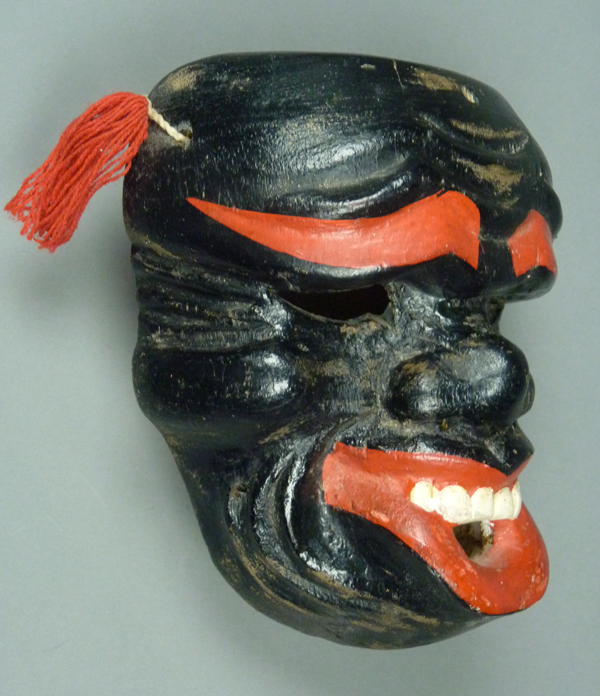
Mixtec Negrito mask from Pinotepa Nacional, Oaxaca and the surrounding villages.
Mask 39 (page 39), “Character unknown…Guerrero,” is very likely to be a decorative mask. If you have the Changing Faces book available, study the painted eyes on this mask. One frequently finds these flamboyantly painted eyes on decorative masks. Mask 70 (page 52)—”Character unknown (Decorative?). Attributed to Chivo type… State unknown,” is an example of a class of Mexican masks that are surely decorative! The feature of this mask that makes one think of a Chivo mask is the clothesline of ribbons that stretches from horn to horn. The next photo will show an example of a genuine Macho Cabrillo or Chivo mask. These are used by the Otomí Indians, from El Nante, Hidalgo. The face of the mask measures 6 1/2″ tall x 4 1/2″ wide, with horns it is 14″ tall x 12″ across the points. 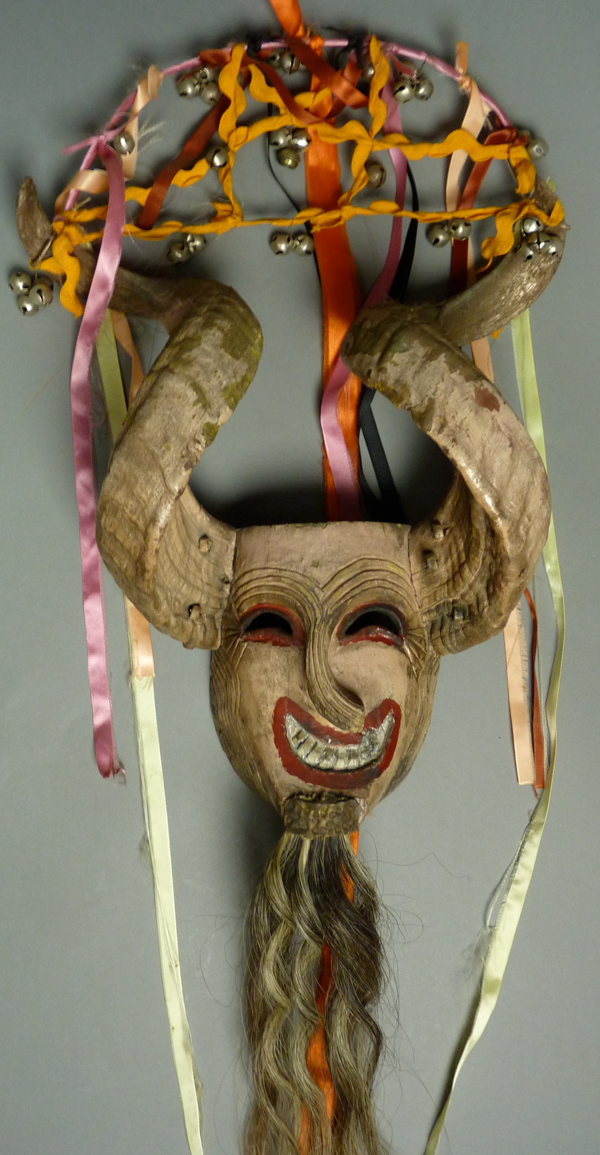
Mask 71 (page 52) is correctly described by the authors as a decorative copy of a Tlacololero mask. I call these “Technicolor Tlacololeros.” They are remarkably oversized (35 x 22.5 cm, or about 14″ tall and 10″ wide). The point that I want to make is that authentic Tlacololero masks have this form, with less exaggeration. See following photo of a straight Tlacololero (12″ tall x 8 1/4″ wide). Note the differential staining on the back.
This is the face of an authentic oversized Tlacalolero mask. 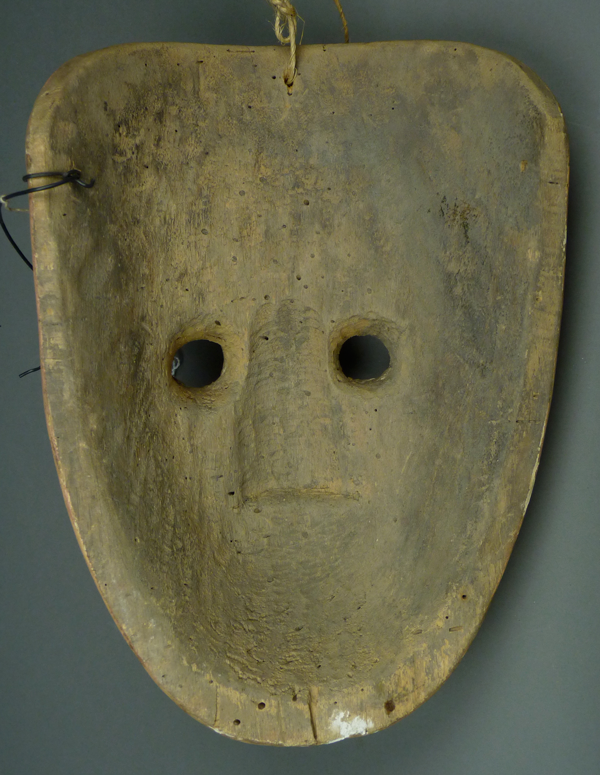
And this is the back of the oversized Tlacalolero mask. Note the differential staining, along with pinholes from an old infestation.
Masks 82 and 83 (page 57)— “Character unknown. Tin. San Luis Potosí,” are Judíos, who dance during Holy Week (Semana Santa) in various towns in the Mexican state of San Luis Potosí. The photo that follows is of a wooden Judio from my collection that, surprisingly, was apparently modeled on such a tin version!The majority of the Judio masks were made of wood, but I find the tin ones quite charming. 
Wooden Judio mask from San Luis Potosí. 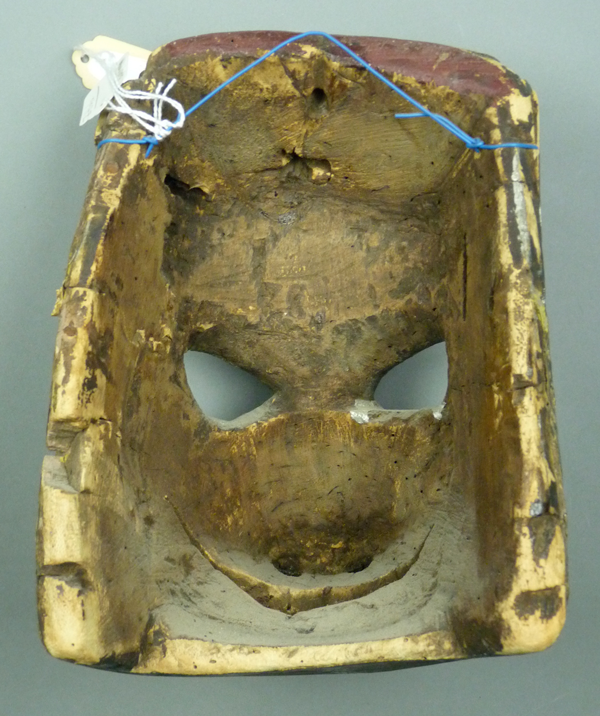
The back of the wooden Judio mask.
Mask 98 (66)—”Old man character. Dance unknown… Guerrero,” is probably from the Manueles dance. The following photo shows my similar mask from that dance, worn by a character who represents “Time.” The top part is leather; perhaps it was originally fur.
The face of “Time.”
The back of the mask of Time. I purchased this mask from Jaled Muyaes and Estela Ogazon. I call your attention to the number- 2474, on the back. Jaled and Estela used such numbers to organize the masks in a mask exhibition that occurred in 1981, at the Museo de Ciencias y Arte, in Mexico City, a show that was sponsered by U.N.A.M. There is a brief description in Spanish of this exhibition, along with some photos, in the following book: Mascaras, Danzas y Fiestas de Michoacán, by Néstor García Canclini and Amparo Sevilla Villalobos (pages 70 -73). This is one of the masks that was exhibited. The Máscaras catalogue, with Estela Ogazon as the listed author, was associated with that show.
In my next three posts I will discuss valuable dance photos, authentic dance masks, and decorative masks in Mexican Masks, by Donald Cordry.

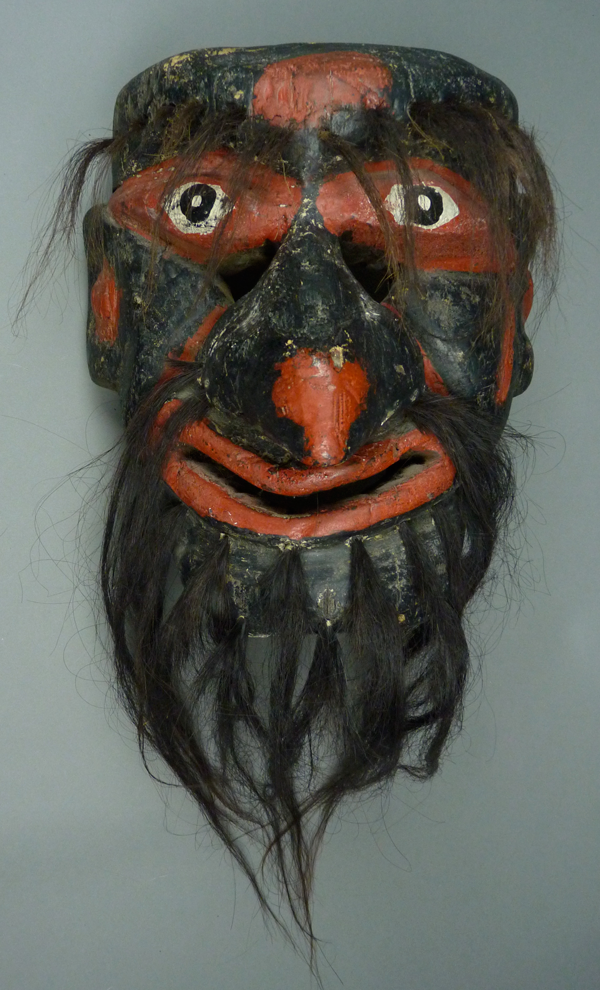
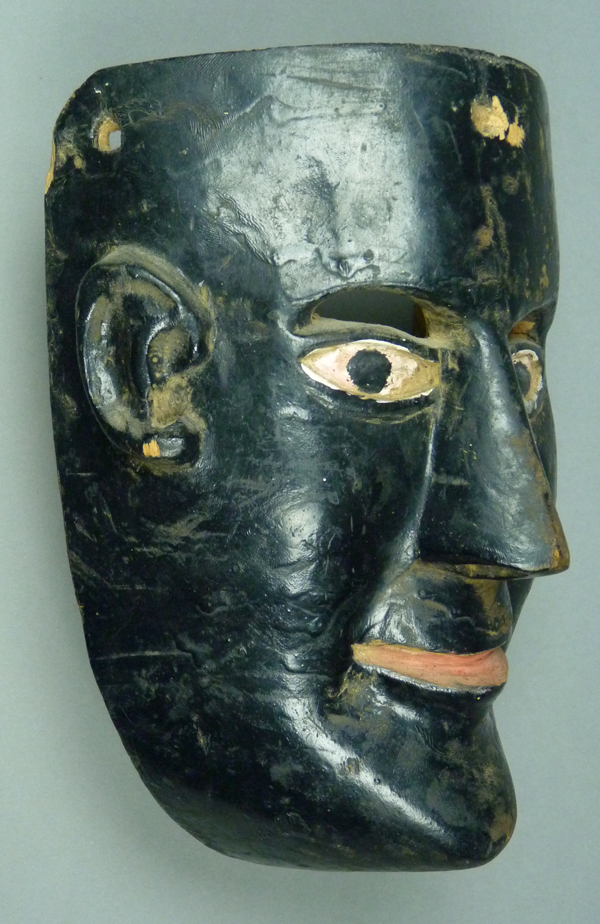
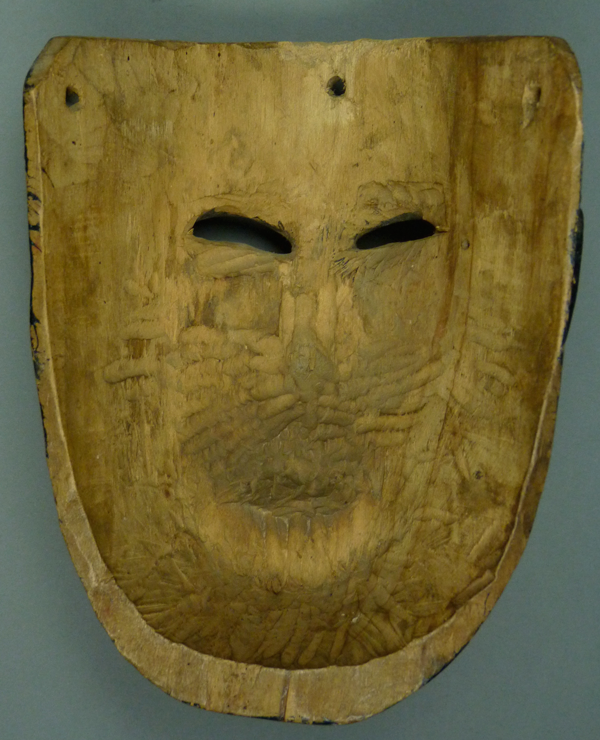
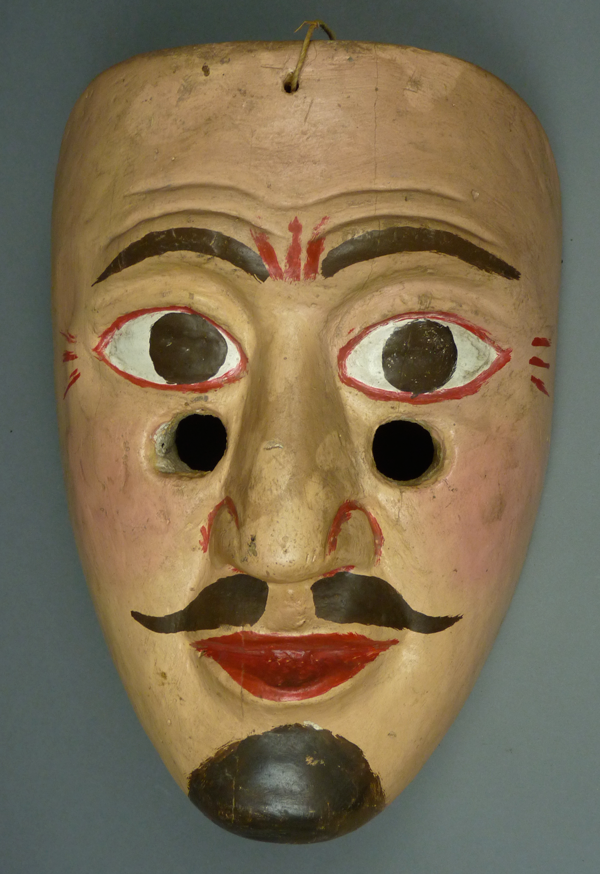
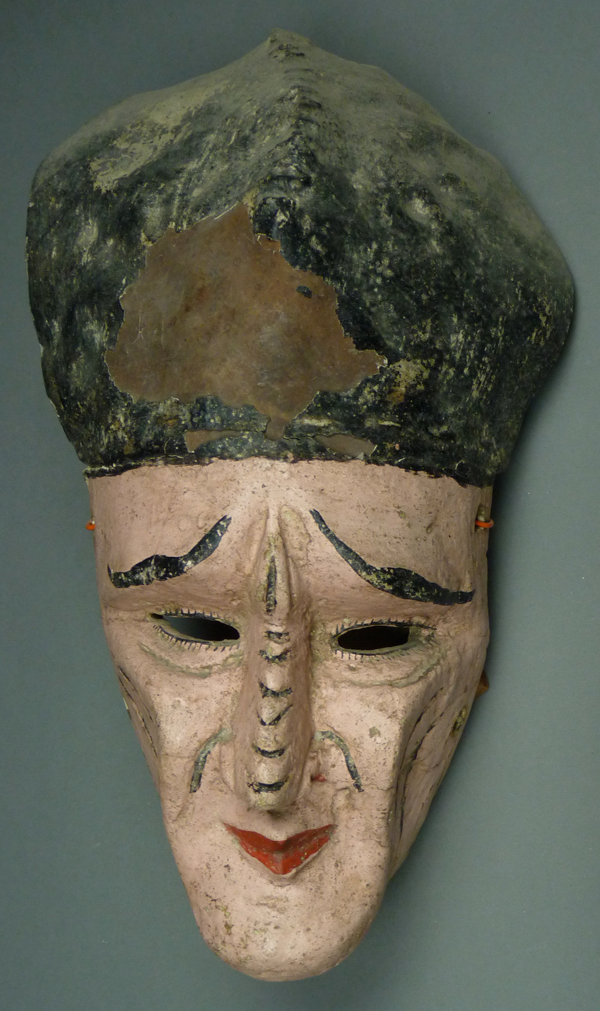
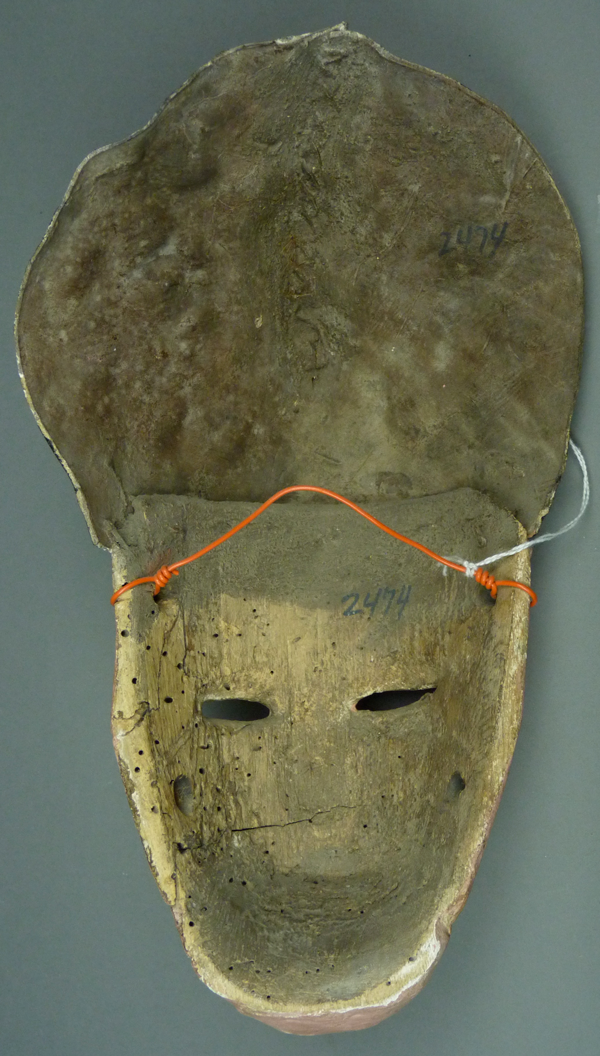
I want to congratulate Bryan for all of his work. It is great to move our understanding of Mexican masks back closer to the artists who created them. He gives those artists faces and names. I also appreciate his including some our discussion of the distinction between “dance masks” and “decorative masks.” Ever since Donald Cordry’s book came out, that discussion seems reductionist – “authentic” vs “scam.” Cordry’s book was so easy to attack that everyone wanted to shoot one of the fish in the barrel. I think of the book as a piece of folk art: a wonderful record of Indians telling stories to an aging anthropologist. It is a variation on Gary Larsen’s wonderful cartoon:
Setting aside the strange claims of the book, there are many of his masks that have been relegated to the “decorative” refuse pile that are amazing tour-de-force of imagination and carving. For example, take a look at those that Cordry’s lists as “possible devil masks.” I would love to know the story of their carvers and their artistic inspiration. Given the richness of the design, it seems unlikely that they sprung simply from Cordry’s predilections (as is often claimed). If they are not appropriate for an ethnographic museum, they do deserve to be in a contemporary art museum. They fit so interestingly with both the Mexican surrealist movement around WWII as well as the explosion of magical realism that was happening at the time Cordry was collecting them. I would love to see an exhibition that explored those relationships. Please apply to the Getty and add it to their big survey of Latin American art – L.A., L.A.
As Bryan mentioned in the above piece, the bearded masks also fascinate me. The ones in Chicago collections are not only of extraordinary artistic value but they are made from exceptionally large and high quality pieces of wood. These carvers had access to materials that is beyond those of most village carvers. I knew these masks before I ever got to Rome. When I saw the baroque fountains and statues – Neptune, Moses, etc – with the wonderfully extravagant beards, I immediately associated them with the Mexican carvers. Think Trevi Founatian:
The Mexican carvers would have had easy access to images of Bernini’s and Michelangelo’s work as well as all the fountains. But it would not surprise me if some of them had actually been to Rome. A few years back, I did an art project with a Maori tribe in New Zealand. The people in the fishing village had not travel a lot, but the one place that many of them had been was Salt Lake City, Utah. The entire tribe had converted to Mormonism early in the 20th century. The Mother Church was on top of their bucket list. I can image that the same would be true for the santeros and Rome.
Similarly, it is interesting to unpack the category of “authentic” dance masks. There are the master carvers that Bryan as documented so well. Among those, it would be interesting to look at those who were carving entire sets for the elaborate narrative dance sequences versus those that were carving commissions for individual families participating in the festivals. Then there are the carvers who must succeed in capturing shamanistic forces during the carving process as with the Pascola masks – that must be quite a different process.
Equally interesting are the more spontaneous mask traditions where the individual dancer has his or her creative moment to interpret or invent the figure for that year’s festival. Many are amateurish. (Indeed, they may be just additions to a plastic U.S. Halloween mask). But when the person hits it, they are wonderful. And some of my most exciting masks are these types. Sometimes the creator is also proud and has written his name on the inside.
Bryant has done lots. I hope others will also pick up on this interest.
I found your page while researching a mask we have recently got.It is very old and has long curly beard and hair. It has the nose and eye slits also.I would be glad to send pictures if you wish.
Hi Janie
If you pull down the “Ask or Tell about a Mask” option on top, you can send me three photos of your mask. I would be interested to see it.
Bryan